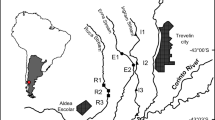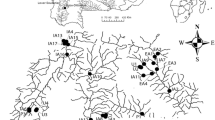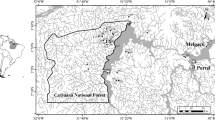Abstract
Conversion of native forest to pastures is a common practice worldwide; it has complex effects on river biota that are related to activity type and intensity. This work was conducted in order to evaluate the effects of cattle grazing on environmental features and to select the most appropriate measures based on the macroinvertebrate community as indicators of ecological changes. Physicochemical features, riparian ecosystem quality, habitat condition, and benthic macroinvertebrates were investigated in streams draining pastures and were compared to reference streams located in nonimpacted native forested catchments. Strong evidence of sediment deposition was observed at pasture streams, which had higher percentage of sand in the streambed but also increased levels of suspended solids. Pasture sites had significantly higher water temperature and conductivity as well as lower dissolved oxygen concentrations than did forested sites. Both riparian quality and in-stream habitat condition were degraded at pasture sites. Among metrics, total richness, Ephemeroptera, Plecoptera, and Trichoptera (EPT) richness, Plecoptera richness, Shannon diversity, percentage of dominant taxon, percentage of Chironomidae species, shredder richness, and percentage of predator resulted to be the most consistent measures by displaying stronger responses to impairment. Our results suggest that forest conversion to pasture for livestock practices is diminishing macroinvertebrate biodiversity and potentially changing functioning and dynamics of Patagonian mountain streams as well. Damage prevention on riverine landscapes by restoring riparian ecosystems, replanting missing vegetation in buffer areas, and limiting livestock access to the riverbanks could contribute to enhance the ecological integrity at converted areas. A more extended and comprehensive use of macroinvertebrate metrics could contribute to better understand and evaluate impact effects of these extended land use activities and to promote conservation strategies.






Similar content being viewed by others
References
Allan, J. D. (2004). Influence of land use and landscape setting on the ecological status of rivers. Limnetica, 23(3-4), 187–198.
Álvarez-Cabria, M., Barquín, J., & Antonio Juanes, J. (2010). Spatial and seasonal variability of macroinvertebrate metrics: do macroinvertebrate communities track river health? Ecological Indicators, 10(2), 370–379.
Armitage, P. D., Moss, D., Wright, J. F., & Furse, M. T. (1983). The performance of a new biological water quality score system based on macroinvertebrates over a range of unpolluted running water sites. Water Research, 17, 333–347.
Arnaiz, O. L., Wilson, A. L., Watts, R. J., & Stevens, M. M. (2010). Influence of riparian condition on aquatic macroinvertebrate communities in an agricultural catchment in south-eastern Australia. Ecological Research, 26(1), 123–131.
Barbour, M. T., Gerritsen, J., Griffith, G. E., Frydenborg, R., McCarron, E., White, J. S., & Bastian, M. L. (1996). A framework for biological criteria for Florida streams using benthic macroinvertebrates. Journal of the North American Benthological Society, 15(2), 185–211.
Barbour, M.T., Gerritsen, J., Snyder, B.D., & Stribling, J.B. (1999). Rapid bioassessment protocols for use in streams and wadeable rivers: periphyton, benthic macroinvertebrates and fish, 2nd ed. U.S. Environmental Protection Agency, Washington, DC. EPA. 841-b-99-002.
Becker, A., & Robson, B. (2009). Riverine macroinvertebrate assemblages up to 8 years after riparian restoration in a semirural catchment in Victoria, Australia. Marine and Freshwater Research, 60, 1309–1316.
Binckley, C., & Resetarits, W. J. (2009). Spatial and temporal dynamics of habitat selection across canopy gradients generates patterns of species richness and composition in aquatic beetles. Ecological Entomology, 34(4), 457–465.
Bonada, N., Prat, N., Resh, V. H., & Statzner, B. (2006). Developments in aquatic insect biomonitoring: a comparative analysis of recent approaches. Annual Review of Entomology, 51, 495–523.
Brand, C., & Miserendino, M. L. (2011). Characterizing Trichoptera trophic structure in rivers under contrasting land use in Patagonia, Argentina. In K. Majecka, J. Majecki, & J. Morse (Eds.), Proceedings of the 13th international symposium on trichoptera (pp. pp. 29–40). Bialowieza: Magnolia Press.
Buendia, C., Gibbins, C. N., Vericat, D., Batalla, R. J., & Douglas, A. (2013). Detecting the structural and functional impacts of fine sediment on stream invertebrates. Ecological Indicators, 25, 184–196.
Cairns, J., Jr., McCormic, P., & Niederlehner, B. (1993). A proposed framework for developing indicators of ecosystem health. Hydrobiologia, 263, 1–44.
Carabelli, F., & Scoz, R. (2008). Human-Induced Alterations in Native Forests of Patagonia, Argentina. In: R. Lafortezza, J. Chen, R. Sanesi, & T. Crow, T. (Eds.), Patterns and Processes in Forest Landscapes (pp. 89-105). Springer Netherlands
Castela, J., Ferreira, V., & Graça, M. A. S. (2008). Evaluation of stream ecological integrity using litter decomposition and benthic invertebrates. Environmental Pollution, 153(2), 440–449.
Collier, K. J. (2008). Temporal patterns in the stability, persistence and condition of stream macroinvertebrate communities: relationships with catchment land-use and regional climate. Freshwater Biology, 53(3), 603–616.
Compin, A., & Céréghino, R. (2007). Spatial patterns of macroinvertebrate functional feeding groups in streams in relation to physical and land-cover in southwestern France. Landscape Ecology, 22, 1215–1225.
Dale, V. H., & Beyeler, S. C. (2001). Challenges in the development and use of ecological indicators. Ecological Indicators, 1, 3–10.
Danger, A., & Robson, B. (2004). The effects of land use on leaf-litter processing by macroinvertebrates in an Australian temperate coastal stream. Aquatic Sciences, 66(3), 1–9.
Davies, P. E., & Nelson, M. (1994). Relationships between riparian buffer widths and the effects of logging on stream habitat, invertebrate community composition and fish abundance. Australian Journal of Marine and Freshwater Research, 45, 1289–1305.
Davies-Colley, R., & Smith, D. (2001). Turbidity, suspended sediment and water clarity: a review. Journal of American Water Resources Association, 37, 1085–1101.
del Valle, H. F., Elissalde, N. O., Gagliardini, D. A., & Milovich, J. (1998). Status of desertification in the patagonian region: assessment and mapping from satellite imagery. Arid Soil Research and Rehabilitation, 12, 1–27.
Domínguez, E., & Fernández, H. R. (2009). Macroinvertebrados bentónicos sudamericanos. Sistemática y biología. Tucumán, Argentina: Fundación Miguel Lillo.
Gordon, N. D., McMahon, T. A., Finlayson, B. L., Gippel, C. J., & Nathan, R. J. (2004). Stream hydrology. An introduction for ecologists. Sussex, England: John Wiley & Sons, Ltd.
Harrison, S., & Harris, I. (2002). The effects of bankside management on chalk stream invertebrate communities. Freshwater Biology, 47, 2233–2245.
Kutschker, A., Brand, C., & Miserendino, M. L. (2009). Evaluación de la calidad de los bosques de ribera en ríos del NO del Chubut sometidos a distintos usos de la tierra. Ecología Austral, 19, 19–34.
Larsen, S., Pace, G., & Ormerod, S. J. (2011). Experimental effects of sediment deposition on the structure and function of macroinvertebrate assemblages in temperate streams. River Research and Applications, 267, 257–267.
Lester, R. E., & Boulton, A. J. (2008). Rehabilitating agricultural streams in Australia with wood: a review. Environmental Management, 42(2), 310–326.
Magner, J., Vondracek, B., & Brooks, K. N. (2008). Grazed riparian management and stream channel response in southeastern Minnesota (USA) streams. Environmental Management, 42(3), 377–390.
Magoba, R., & Samways, M. (2010). Recovery of benthic macroinvertebrate and adult dragonfly assemblages in response to large scale removal of riparian invasive alien trees. Journal of Insect Conservation, 14(6), 627–636.
Maloney, K. O., & Feminella, J. W. (2006). Evaluation of single- and multi-metric benthic macroinvertebrate indicators of catchment disturbance over time at the fort benning military installation, Georgia, USA. Ecological Indicators, 6(3), 469–484.
Maloney, K. O., Mulholland, P. J., & Feminella, J. W. (2005). Influence of catchment-scale military land use on physical and organic matter conditions in small southeastern plains streams (USA). Environmental Management, 35, 667–691.
Mesa, L. M. (2014). Influence of riparian quality on macroinvertebrate assemblages in subtropical mountain streams. Journal of Natural History, 48(19-20), 1153–1167.
Miserendino, M. L. (2004). Effects of landscape and desertification on the macroinvertebrate assemblages of rivers in Andean Patagonia. Archive fur Hydrobiology, 159, 185–209.
Miserendino, M. L., & Masi, C. I. (2010). The effects of land use on environmental features and functional organization of macroinvertebrate communities in Patagonian low order streams. Ecological Indicators, 10(2), 311–319.
Miserendino, M. L., & Pizzolón, L. (1999). Rapid assessment of river water quality using macroinvertebrates: a family level biotic index for the Patagonic Andean zone. Acta Limnologica Brasieliensia, 11, 137–148.
Miserendino, M. L., Brand, C., & Di Prinzio, C. Y. (2008). Assessing urban impacts on water quality, benthic communities and fish in streams of the Andes Mountains, Patagonia (Argentina). Water, Air, and Soil Pollution, 194(1-4), 91–110.
Miserendino, M. L., Casaux, R. J., Archangelsky, M., Di Prinzio, C. Y., Brand, C., & Kutschker, A. M. (2011). Assessing land-use effects on water quality, in-stream habitat, riparian ecosystems and biodiversity in Patagonian northwest streams. Science of the Total Environment, 409(3), 612–624.
Munné, A., Prat, N., Solá, C., Bonada, N., & Rieradevall, M. (2003). A simple field method for assessing the ecological quality of riparian habitat in rivers and streams: QBR index. Aquatic Conservation: Marine and Freshwater Ecosystems, 13(2), 147–163.
Niyogi, D., Koren, M., Arbuckle, C. J., & Townsend, C. R. (2007). Stream communities along a catchment land use gradient: subsidy-stress responses to pastoral development. Environmental Management, 39, 213–225.
Parkyn, S., & Smith, B. (2011). Dispersal constraints for stream invertebrates: setting realistic timescales for biodiversity restoration. Environmental Management, 48(3), 602–614.
Paruelo, J. M., Beltrán, A., Jobbágy, E., Sala, O. E., & Golluscio, R. A. (1998). The climate of Patagonia: general patterns and controls on biotic processes. Ecologia Austral, 8, 85–101.
Plafkin, J., Barbour, M.T., Porter, K.D., Gross, S.K., & Hughes, R.M. (1989). Rapid bioassessment protocols for use in streams and rivers: Benthic macroinvertebrate and fish. Office of Water, US Environmental Protection Agency, Washington, DC, EPA/440/4.
Quinn, J. M. (2000). Effects of pastoral development. In K. J. Collier & M. J. Winterbourn (Eds.), New Zealand stream invertebrates: ecology and implications for management (pp. 208–229). Christchurch: New Zealand Limnological Society.
Quinn, J. M., & Hickey, C. W. (1990). Characterization and classification of benthic invertebrate communities in 88 New Zealand rivers in relation to environmental factors. New Zealand Journal of Marine and Freshwater Research, 24, 387–409.
Read, D., & Barmuta, L. (1999). Comparisons of benthic communities adjacent to riparian native eucalypt and introduced willow vegetation. Freshwater Biology, 42, 359–374.
Richardson, J. S. (2008). Aquatic arthropods and forestry: effects of large- scale land use on aquatic systems in Nearctic temperate regions. Canadian Entomologist, 140, 495–509.
Richardson, J. S., & Danehy, R. J. (2007). Zones in temperate forests. Forest Science, 53(2), 131–147.
Riley, R. H., Townsend, C. R., Niyogi, D. K., Arbuckle, C. A., & Peacock, K. A. (2003). Headwater stream response to grassland agricultural development in New Zealand. New Zealand Journal of Marine and Freshwater Research, 37, 389–403.
Roque, F., Strixino, G., Agostinho, R. C., & Fogo, J. C. (2003). Benthic macroinvertebrates in streams of the Jaragua State Park (Southeast of Brazil) considering multiple spatial scales, (Ward 1989). Journal of Insect Conservation, 7, 63–72.
Rutherford, J., Blackett, S., Blackett, C., Saito, L., & Davies-Colley, R. J. (1997). Predicting the effects of shade on water temperature in small streams. New Zealand Journal of Marine and Freshwater Research, 31, 707–721.
Rutherford, J. C., Marsh, N. A., Davies, P. M., & Bunn, S. E. (2004). Effects of patchy shade on stream water temperature: how quickly do small streams heat and cool? Marine and Freshwater Research, 55, 737–748.
Scarsbrook, M. R., & Halliday, J. (1999). Transition from pasture to native forest land-use along stream continua: effects on stream ecosystems and implications for restoration. New Zealand Journal of Marine and Freshwater Research, 33, 293–310.
Sokal, R. R., & Rohlf, F. J. (1995). Bometry (3rd ed.). New York: W.H. Freeman and Company. 887 pp.
Tell, G., Izaguirre, I., & Quintana, R. (1997). Flora y fauna patagónicas. Bariloche: Ediciones Caleuche.
ter Braak, C.J.F., & Smilauer, P. (1998). CANOCO reference manual and user´s guide to Canoco for Windows. Software for Canonical Community Ordination (Version 4). Microcomputer power. Ithaca, N.Y.
ter Braak, C. J. F., & Smilauer, P. (1999). CANOCO for Windows (Version 4.02). A FORTRAN program for canonical community ordination. Wageningen: Centre for Biometry Wageningen.
Thompson, R. M., & Townsend, C. R. (2004). Land-use influences on New Zealand stream communities: effects on species composition, functional organization, and food-web structure. New Zealand Journal of Marine and Freshwater Research, 38(4), 595–608.
Vondracek, B., Frost, J. A., & Mumford, K. G. (2000). Impacts of rotational grazing and riparian buffers on physicochemical and biological characteristics of Southeastern Minnesota USA, Streams. Environmental Management, 26(6), 629–641.
Wood, P. J., & Armitage, P. D. (1997). Biological effects of fine sediment in the lotic environment. Environmental Management, 21(2), 203–217.
Zimmerman, J. K. H., Vondracek, B., & Westra, J. V. (2003). Agricultural land use effects on sediment loading and fish assemblages in two Minnesota (USA) watersheds. Environmental Management, 32, 93–105.
Aknowledgments
This study was supported by CONICET (PIP 5733) and Project A.W.A.R.E. Foundation (P-001036) and PADI Foundation (19/2006). The authors wish to thank Dr. C.Y. Di Prinzio, Dr. R. Casaux, and Lic. C. Masi for fieldtrip assistance, Dr. M. Archangelsky and Dr. P. Pessacq for helping in species identification, Dr. G. Martin for comments on the manuscript, and the two anonymous reviewers for valuable comments that greatly improved the manuscript. This is a Scientific Contribution no. 118 from LIESA.
Author information
Authors and Affiliations
Corresponding author
Appendix 1
Appendix 1
Rights and permissions
About this article
Cite this article
Brand, C., Miserendino, M.L. Testing the Performance of Macroinvertebrate Metrics as Indicators of Changes in Biodiversity After Pasture Conversion in Patagonian Mountain Streams. Water Air Soil Pollut 226, 370 (2015). https://doi.org/10.1007/s11270-015-2633-x
Received:
Accepted:
Published:
DOI: https://doi.org/10.1007/s11270-015-2633-x




